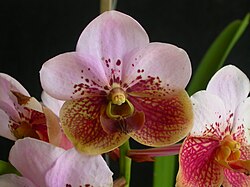Vanda sanderiana
| Height: | ⇕ | 8 in"in" can not be assigned to a declared number type with value 8. to 48 in"in" can not be assigned to a declared number type with value 48. |
|---|---|---|
| Width: | ⇔ | 8 in"in" can not be assigned to a declared number type with value 8. to 20 in"in" can not be assigned to a declared number type with value 20. |
| Lifespan: | ⌛ | perennial |
| Origin: | ✈ | Philippines |
| Exposure: | ☼ | sun, part-sun |
|---|---|---|
| Water: | ◍ | moist |
| Features: | ✓ | flowers |
| USDA Zones: | 11 to 12 | |
| Flower features: | ❀ | red, brown, pink |
|
Vanda > |
Euanthe sanderiana is a flower of the orchid family. It is commonly called Waling-waling[1] in the Philippines and is also called Sander's Euanthe,[2] after Henry Frederick Conrad Sander,[3] a noted orchidologist. The orchid is considered to be the "Queen of Philippine flowers" and is worshiped as a diwata by the native Bagobo people.[3]
Heinrich Gustav Reichenbach originally named Euanthe sanderiana as Vanda sanderiana.
It has two forms, pink and white, also referred to as alba. M. Roebelin discovered the original pink variety in the Philippines in 1881 or 1882. Rudolf Schlechter separated Euanthe from Vanda in 1914 due to structural differences in the flowers.[4] For breeding purposes and registration by the Royal Horticultural Society, however, it is still treated as a Vanda.[5]
Euanthe sanderiana is endemic to Mindanao in the provinces of Davao, Cotabato, and Zamboanga where it is found on the trunks of dipterocarp trees at elevations below 500 meters. Over-collected, the plant is considered rare in nature.[6] It is often used in hybridization.[7]
Studies have shown that when raised at high altitude, the plant bears flowers early.[8]
Read about Vanda sanderiana in the Standard Cyclopedia of Horticulture
|
|---|
|
Vanda sanderiana, Reichb. f. St. very leafy: lvs. rigid, fleshy, recurved, 1 ft. long, strap-shaped, truncate, with 2-3 teeth at the apex: raceme bearing about 12 fls. each 5 in. across, with the broad sepals and petals overlapping: sepals orbicular, the dorsal one smaller, pale lilac, dotted at the base, the lower pair tawny yellow veined and tessellated with brownish crimson; petals smaller, rhomboid obovate, colored like the dorsal sepals; lateral lobes of the labellum forming a cup-like base, middle lobe subquadrate, reniform, much smaller than the sepals, dull crimson. Sept. Philippines.— A very remarkable free-flowering species. Var. Froebeliana, Cogn. Fls. very large, nearly circular in outline, richly colored. Var. roseo-alba, Hort. Upper sepal and petals nearly white with purple spots; lower petals greenish with purple veining.
|
Cultivation
Propagation
Pests and diseases
Varieties
The Philippine Orchid Society, which incorporates an image of the flower in its logo, states that the species has three varieties:[9]
- Vanda sanderiana var. albata Reichb. f. in Gard. Chron. ser. 3.2 (1887) 9. Esmeralda Sanderiana var. albata Will
- Described by Heinrich Gustav Reichenbach in The Gardeners' Chronicle in 1887, the plant's flower size is smaller than that of the species. Its lateral sepals are yellowish-green with white margins. Its dorsal sepal and petals are white with purple spots at the base. The labellum has purple dots. This plant was reported from Davao del Sur and South Cotabato on Mindanao Island where it grows as an epiphyte at elevations to 500 meters. This variety is now extremely rare in its natural habitat.
- Vanda sanderiana var. froebeliana cogn. in Dict. Icon. des. Orch.Vanda t. 12 a (1903)
- This variety has bright rose flower stalks and has very large flowers compared to the species. The lateral sepals are bright yellow, with rose coloration towards the margins and densely covered with large purple reticulated veins. The dorsal sepal and petals are rose-colored on the upper half, while the lower half has brownish-purple spots.
- Vanda sanderiana var. labello-viridi Linden & Rodigas in Lindenia 1:85, t (1885) 40. Esmeralda sanderiana var. labello-viridi Will
- This variety is similar to the species, with the exception that the lip or labellum is green with crimson stripes.
Gallery
If you have a photo of this plant, please upload it! Plus, there may be other photos available for you to add.
References
- Standard Cyclopedia of Horticulture, by L. H. Bailey, MacMillan Co., 1963
External links
- w:Vanda sanderiana. Some of the material on this page may be from Wikipedia, under the Creative Commons license.
- Vanda sanderiana QR Code (Size 50, 100, 200, 500)
- ↑ "Euanthe sanderiana(Waling-waling Orchid)". Retrieved on 2009-08-23.
- ↑ "Euanthe sanderiana [Rchb.f Schlechter 1914]". Retrieved on 2009-08-23.
- ↑ 3.0 3.1 Tacio, Henrylito D.. "Waling-Waling: Magnificent Yet Endangered". Retrieved on 2009-08-26.
- ↑ "Plant of the Week 01/07/2002 Euanthe Sanderiana alba Schlechter". Retrieved on 2009-08-23.
- ↑ "Vanda Sanderiana at Fender's Flora Orchids". Retrieved on 2009-08-23.
- ↑ Cite error: Invalid
<ref>tag; no text was provided for refs namedESC - ↑ "Vanda sanderiana (plant)". Retrieved on 2009-08-23.
- ↑ Ramasasa, Cris. "Waling-Waling Orchids Bears Flowers Early When Raised At High Altitude: Says Study". Retrieved on 2008-03-19.
- ↑ "Vanda sanderiana". Retrieved on 2008-08-27.

